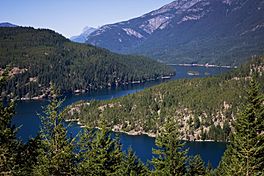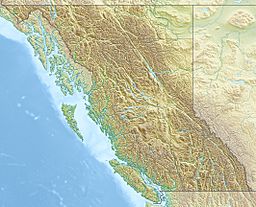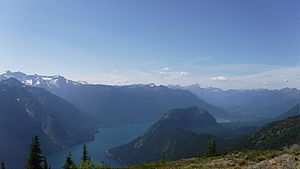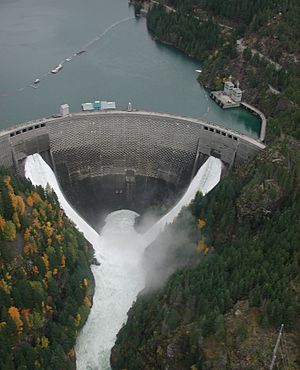Ross Lake (Washington) facts for kids
Quick facts for kids Ross Lake |
|
|---|---|

Ross Lake, 2012
|
|
| Location | Ross Lake National Recreation Area, Whatcom County, Washington, United States; Skagit Valley Provincial Park, British Columbia, Canada |
| Coordinates | 48°43′54″N 121°04′02″W / 48.73167°N 121.06722°W |
| Lake type | reservoir |
| Basin countries | United States, Canada |
| Max. length | 23 mi (37 km) |
| Max. width | 1.5 mi (2.4 km) |
| Max. depth | 540 ft (160 m) |
| Surface elevation | 1,604 ft (489 m) |
| Islands | Cat Island, Tenmile Island, Little Jerusalem Island, Cougar Island |
| Settlements | none |
Ross Lake is a big lake found in the North Cascades mountains. It stretches across northern Washington in the United States and into southwestern British Columbia, Canada. This long lake runs about 23 miles (37 km) from north to south and can be up to 1.5 miles (2.5 km) wide. Its surface is 1,604 feet (489 m) above sea level.
The part of Ross Lake in the U.S. is inside the Ross Lake National Recreation Area. The North Cascades National Park is right next to it on the west and south. To the east of the lake is the Pasayten Wilderness. In British Columbia, the lake is part of Skagit Valley Provincial Park. Manning Provincial Park is also nearby to the east.
How Ross Lake Was Formed
Ross Lake is actually a reservoir, which means it's a lake created by people. It was formed by building a large wall, called Ross Dam, across the Skagit River. This dam helps to make electricity for places like Seattle, Washington.
After the water leaves Ross Lake, it flows through two more reservoirs before reaching Puget Sound. Many high mountains surround Ross Lake. These include Hozomeen Mountain, Ruby Mountain, Desolation Peak, and Jack Mountain. The top of Jack Mountain is more than 7,000 feet higher than the lake!
Many rivers and creeks flow into Ross Lake. Some of these are the upper Skagit River, Hozomeen Creek, Silver Creek, and Ruby Creek. Most of these smaller waterways start from glaciers and large snowfields high up in the North Cascades mountains.
Building Ross Dam
Ross Dam, which was first called Ruby Dam, was built in three main steps. Construction happened between 1937 and 1949. Today, the dam stands 540 feet (160 m) tall.
There were plans to make the dam even bigger. However, in 1984, Seattle City Light made a deal to buy electricity from British Columbia. This agreement meant that the Ross Lake Dam would not be expanded for 80 years. The lake and the dam are named after James D. Ross. He was in charge of the Skagit River Hydroelectric Project, which built the dam.
Fun Things to Do at Ross Lake
Ross Lake is a very popular place for outdoor activities in the North Cascades. Many people visit to enjoy fishing, canoeing, kayaking, and hiking. The trout fishing here is especially well-known.
You won't find fish like salmon or steelhead trout in Ross Lake. This is because natural barriers in the Skagit River prevented these fish from swimming upstream past a certain point.
You can go camping at many spots around the lake. Some campsites can be reached by boat, and others by hiking. You need a free permit for backcountry camping. You can get these permits from the National Park Service in Marblemount.
Ross Lake is also home to a special place called the Ross Lake Resort. This resort floats on the water! It has many cabins and bunkhouses. It is located about a quarter mile from the dam. In the winter, when the lake's water level goes down, the resort moves to the middle of the lake. This happens because the lake's water is lowered each year to help control floods on the Skagit River.
There is a road from the Canadian side of the lake that ends just inside the U.S. If you travel this way, you don't have to check in at an official border crossing. This is because you must go back into Canada to leave the area.






